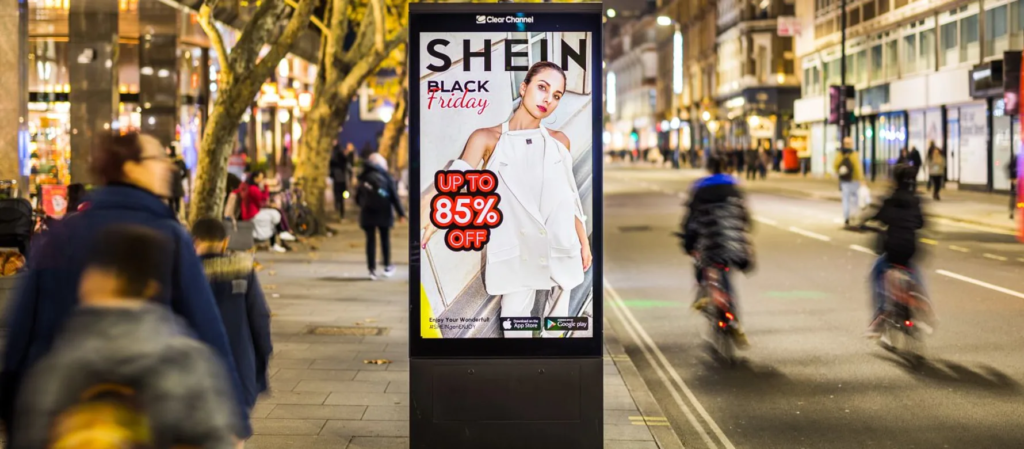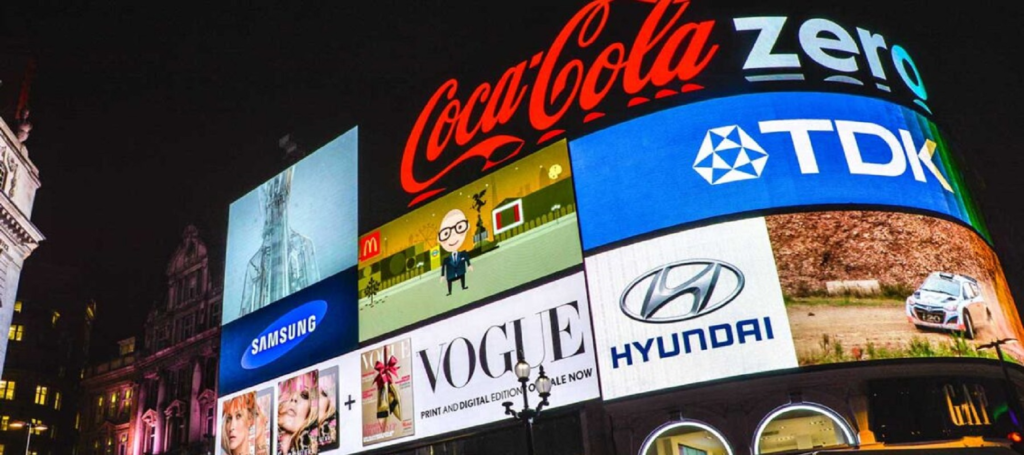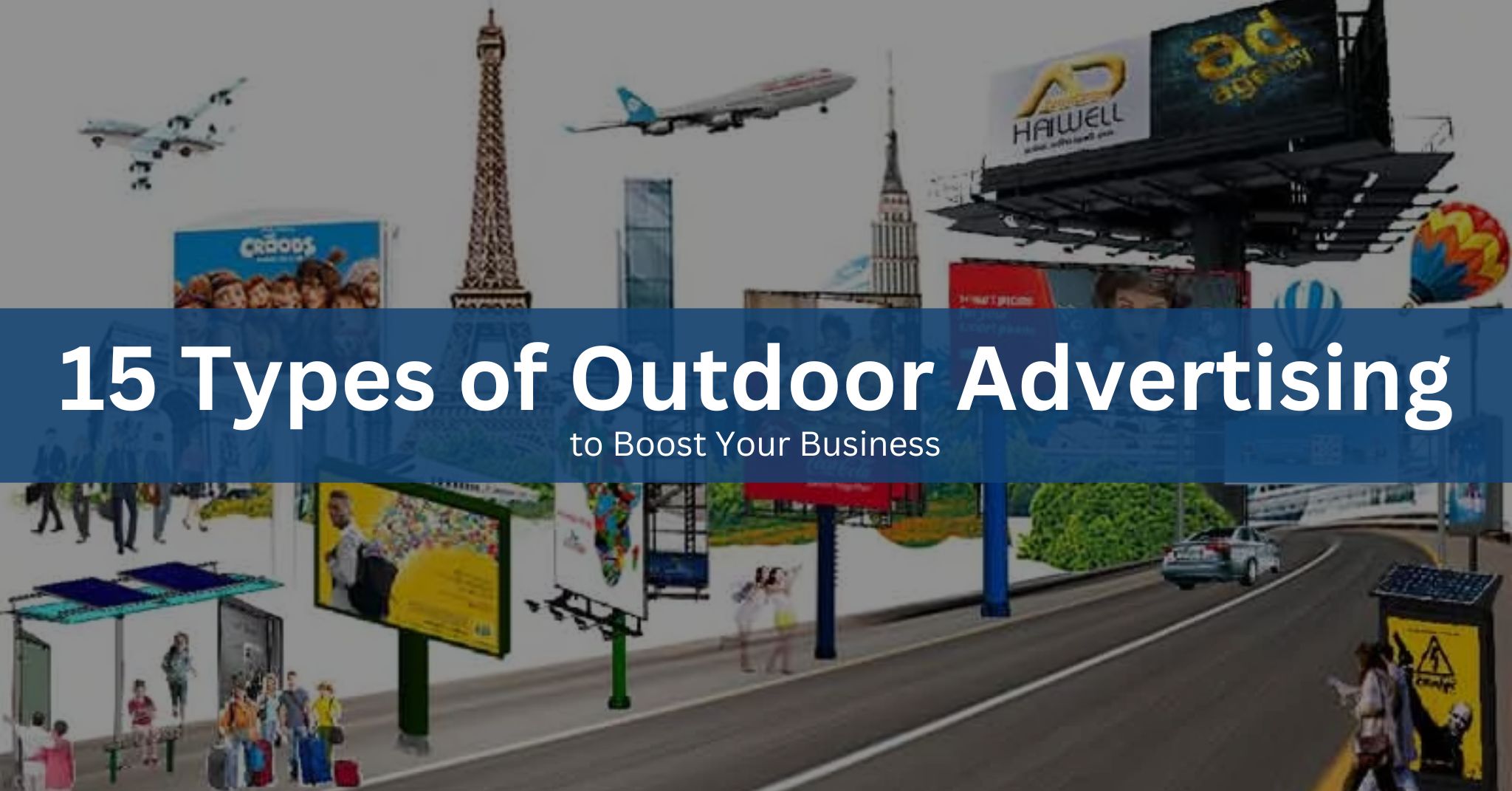Outdoor advertising is a powerful way to increase your business’s visibility and reach a broad audience. From traditional billboards to innovative digital displays, there are many options to consider. In this blog, we’ll explore 15 types of outdoor advertising that can significantly boost your business, explain what outdoor advertising is, and compare traditional outdoor advertising with LED outdoor advertising.

What is Outdoor Advertising?
Outdoor advertising, also known as out-of-home (OOH) advertising, refers to any visual advertising media found outside of the home. This includes billboards, transit ads, posters, and more. It’s designed to reach consumers on the go, capturing their attention in high-traffic areas. Unlike other forms of advertising that rely on media consumption at home or work, outdoor advertising engages people as they navigate their daily routines, making it an effective way to create lasting impressions.
15 Types of Outdoor Advertising

1. Billboards
Billboards are large, static advertisements typically placed along highways and busy streets. They offer high visibility and can reach a wide audience. Due to their size and strategic locations, billboards can make a significant impact, creating strong brand recognition and conveying messages to a diverse group of people.
2. Digital Billboards
Digital billboards use LED screens to display multiple rotating advertisements. They offer flexibility and the ability to quickly update content. These dynamic ads can show a variety of messages in a single location, allowing for real-time updates and targeted advertising based on the time of day or specific events.
3. Transit Advertising
Transit advertising includes ads on buses, trains, subways, and taxis. These ads move through busy areas, targeting commuters. This type of advertising is particularly effective in urban areas where public transportation is widely used, ensuring that your message reaches a large and diverse audience throughout the day.
4. Bus Shelters
Ads placed on bus shelters reach people waiting for public transport, providing a captive audience. These ads are often at eye level, making them hard to miss and providing an excellent opportunity to engage with potential customers during their daily commute.
5. Street Furniture
Street furniture advertising involves ads on benches, kiosks, and other public fixtures. These placements are at eye level and easily noticeable. They are often located in high-traffic areas such as downtown streets, shopping centers, and parks, ensuring high visibility and frequent exposure.
6. Mobile Billboards
Mobile billboards are ads placed on vehicles that travel through high-traffic areas, offering dynamic and mobile visibility. These ads can cover a wide geographic area and can be targeted to specific locations or events, making them a versatile option for reaching potential customers.
7. Point of Sale Displays
These ads are placed near checkout counters in stores, targeting customers ready to make a purchase. Point of sale displays can influence last-minute purchasing decisions and are effective in promoting special offers, new products, or brand messages directly to consumers who are already in a buying mindset.
8. Posters
Posters can be placed in various locations such as shopping malls, subway stations, and university campuses. They are cost-effective and reach specific demographics. Posters are versatile and can be designed to suit various sizes and locations, making them an accessible option for businesses of all sizes.
9. Wallscapes
Wallscapes are large advertisements affixed to the exterior walls of buildings. They provide dramatic and highly visible advertising. Often located in urban areas, wallscapes can cover entire sides of buildings, making a bold statement and capturing the attention of pedestrians and motorists alike.
10. Bridge Banners
Placed on pedestrian bridges or overpasses, bridge banners are highly visible to both pedestrians and motorists. These banners can reach a broad audience and are particularly effective in high-traffic areas, where they can be seen by large numbers of people throughout the day.
11. Lamp Post Banners
These banners are attached to street lamps and are commonly seen in downtown areas and shopping districts. Lamp post banners are often used to promote events, seasonal sales, or local businesses, providing high visibility in pedestrian-friendly areas.
12. Guerrilla Advertising
Guerrilla advertising involves creative and unexpected installations in public spaces to create buzz and engage audiences. This type of advertising relies on unconventional methods to capture attention, making a memorable impact and encouraging word-of-mouth promotion.
13. Inflatables
Inflatable advertisements are large, balloon-like structures used at events or outside stores to attract attention. They are eye-catching and can be customized to represent various products, mascots, or promotional messages, making them a fun and engaging way to attract customers.
14. Airport Advertising
Ads placed in airports target travelers who often have higher disposable incomes. These include banners, digital screens, and sponsored lounges. Airport advertising reaches a captive audience with time to engage with your message, making it a valuable platform for promoting high-end products and services.
15. Retail Advertising
This includes digital displays, posters, and promotional signage within retail environments to target customers in a buying mindset. Retail advertising can influence purchasing decisions and enhance the shopping experience by providing relevant information and promotions directly at the point of sale.
Comparison: Traditional Outdoor Advertising vs. LED Outdoor Advertising
Traditional Outdoor Advertising

- Static Content: Traditional billboards and posters have fixed images that do not change. This can be effective for long-term branding and consistent messaging.
- Lower Initial Cost: Generally, traditional outdoor ads have a lower initial cost compared to digital ads. They are more affordable for small businesses and long-term campaigns.
- Limited Flexibility: Changing content requires physical replacement of the ad, which can be time-consuming and costly. This limits the ability to quickly update messages or react to new marketing opportunities.
- Broad Reach: Effective for long-term branding and reaching a wide audience. Traditional outdoor ads are particularly useful in high-traffic areas where they can be seen by large numbers of people consistently.
LED Outdoor Advertising

- Dynamic Content: Digital billboards and displays can show multiple ads and update content quickly. This allows for greater flexibility and the ability to display timely and relevant messages.
- Higher Visibility: LED screens are bright and eye-catching, especially at night. They can attract attention in various lighting conditions and stand out in busy environments.
- Greater Flexibility: Easily change and schedule different ads based on time of day or special events. This enables targeted advertising and the ability to run multiple campaigns from a single location.
- Higher Initial Cost: The setup cost is higher, but the ability to update content can save money over time. Digital ads also offer potential for higher engagement and return on investment.
FAQs about Outdoor Advertising
1. What is outdoor advertising?
Outdoor advertising encompasses various forms of advertisements displayed in public spaces, targeting people when they are outside their homes.
2. Why is outdoor advertising effective?
It’s effective because it reaches a broad audience, offers high visibility, and can be strategically placed in high-traffic areas.
3. How much does outdoor advertising cost?
The cost varies widely depending on the format, location, and duration of the campaign. Billboards in prime locations can be expensive, while posters may be more affordable.
4. What is the difference between traditional and digital billboards?
Traditional billboards are static, whereas digital billboards use LED screens to display rotating advertisements that can be updated remotely.
5. Can small businesses benefit from outdoor advertising?
Yes, small businesses can benefit greatly by targeting local customers through cost-effective options like posters, bus shelter ads, and mobile billboards.
6. How do I choose the right type of outdoor advertising?
Consider your target audience, budget, and the message you want to convey. Different formats offer different benefits and levels of visibility.
7. What are some creative outdoor advertising ideas?
Guerrilla advertising, inflatables, and wallscapes are some creative options that can make a big impact and create buzz.
8. How long should an outdoor advertising campaign last?
The duration depends on your goals and budget. Campaigns can run for a few weeks to several months. Consistency helps in building brand recognition.
9. What are some common mistakes in outdoor advertising?
Common mistakes include poor location choice, unclear messaging, and not considering the target audience. Ensure your ad is visually appealing and easy to read.
10. How do I measure the success of my outdoor advertising campaign?
Success can be measured through increased brand awareness, higher foot traffic, and sales during and after the campaign. Tools like surveys and tracking codes can help measure effectiveness.
Conclusion
Outdoor advertising offers a diverse range of formats to enhance your business visibility and reach a broad audience. Whether you choose traditional billboards or dynamic LED displays, the right outdoor advertising strategy can significantly boost your brand’s presence and drive business growth. By understanding the different types of outdoor advertising and leveraging their unique benefits, you can create impactful campaigns that capture attention and generate results with Adworth Media.
